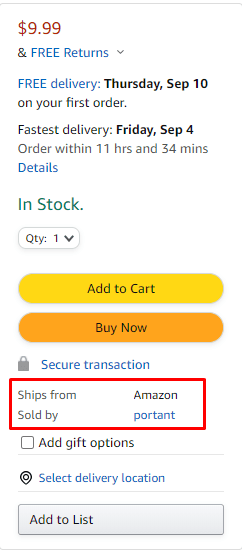-
 11 min. read
11 min. read
-
 Macy Storm
Macy Storm Content Marketing Consultant
Content Marketing Consultant
- Macy is a content marketing consultant with over five years of experience creating content for dozens of industries including home services, recreation, and education. She’s written about every marketing topic under the sun, from SEO to AI to email marketing. Her work has been featured by Search Engine Journal, HubSpot, Entrepreneur, Clutch, and more. In her free time, Macy enjoys crafting, reading comic books, and walking her dog Daisy.
Amazon vs Shopify:
Amazon is an online marketplace where anyone can sell products, while Shopify is a platform that allows businesses to create their own online stores.
Bethany decided to move her business online so she can grow and reach new customers. She’s trying to figure out the best place to move her business online. Many people recommend that she try to open a store on Amazon or to build a site through Shopify.
So, which platform is better for selling your products online — Shopify or Amazon? In this post, we’ll look at the Amazon vs. Shopify debate and provide you with the pros and cons of each platform.
Want to get to the latest tricks and tips for marketing your business online? Subscribe to our email list to get insider information! WebFX campaigns have delivered more than 14,936,451 ecommerce transactions in the last 5 yearsPartner with a team of ecommerce masters!


What’s the difference between Shopify and Amazon?
Amazon and Shopify both enable you to sell your products online, but they are not the same type of platform.
The biggest difference between Shopify vs. Amazon is that Shopify is an ecommerce platform, while Amazon is an online marketplace. When you build a Shopify website, you’re making a stand-alone ecommerce store. Shopify provides you with the tools you need to create your own store.
With Amazon, you’re building a marketplace page for yourself to sell your products alongside other companies. It’s an established marketplace, whereas Shopify focuses on building your own store website and reputation. So, is it better to sell on Amazon or Shopify?
Keep reading to find out!
| Amazon vs. Shopify | Pros | Cons | Fees |
|---|---|---|---|
| Amazon |
|
|
|
| Shopify |
|
|
|
Amazon vs. Shopify: Pros
When you’re asking, “Is Amazon or Shopify better?” it’s critical to look at the pros and cons of each site to help you determine the best fit for your business.
| Amazon vs. Shopify | Pros |
|---|---|
| Amazon |
|
| Shopify |
|
Here are the pros for each platform:
Amazon
Amazon is one of the top platforms for selling your products online. Here are a few pros of selling on Amazon’s webstore vs Shopify:
You get more traffic Amazon has over 213 million unique U.S. visitors each month.
This platform drives millions of people who want to buy the products and services available on Amazon. If you open a store on Amazon, you have access to all this traffic. You can put your products in front of people who are likely to be interested in them.
Safe to say, in the Shopify vs. Amazon debate, Amazon wins when it comes to how much traffic your store can access on launch.
You can have Amazon handle your products When you sell your products on Amazon, you can choose to have Amazon handle it for you. This program is known as Fulfillment by Amazon (FBA).  With the FBA program, you send your products to Amazon’s fulfillment centers.
With the FBA program, you send your products to Amazon’s fulfillment centers.
When someone orders your product, Amazon will pick, pack, and ship the product to the customer. Additionally, Amazon provides customer service if people have an issue with your products in FBA. If you compare Amazon FBA vs. Shopify, you’ll find that this program is only unique to Amazon. Shopify cannot do orders for you — you’re in charge of inventory, packaging, and shipping. This program makes it easy for you to sell your products without having to worry about shipping them and managing customer service after the fact.
You can set up a shop easily
When you look at selling on Amazon vs. Shopify, you’ll find that it’s quick and easy to set up a shop through Amazon. You must create an account and follow the steps in the setup process. Once you have all the steps completed, you’ll list your products and start selling on Amazon.
Amazon enables you to choose a template for your brand’s shop. You can choose between a marquee, product highlight, or product grid setup. These pre-made templates make it easy for you to create your custom storefront.
You have Amazon’s reputation backing you If people haven’t heard of your business before, they may not feel confident about shopping with you.
It can make it difficult for you to sell your products. When you sell on Amazon, however, you have Amazon backing you. People trust Amazon, so when you sell through their platform, they will trust your business too.
They will feel confident buying your products because they know Amazon can help them handle any issues.
Shopify
Is Shopify better than Amazon? There are some features that Shopify has that make it a better option than Amazon. Here are some pros of choosing Shopify in the Shopify vs. Amazon showdown:
You can build a website easily When you build a website through Shopify, you can create a website easily for your business. Shopify enables you to make the ecommerce website you need. Shopify offers a plethora of templates that you can use to start building your website.
You can alter these templates to fit your brand’s style. Shopify’s interface is very user-friendly too. This site builder offers a drag-and-drop feature, which makes it easy for you to customize templates.
Additionally, Shopify sites are fully responsive, meaning they’re already ready to adapt to mobile devices. You don’t need to do additional work to make your site look good on mobile because Shopify integrates responsive design.
You get a range of ecommerce tools When you use Shopify, you get access to numerous tools to help you build the best site for your business. Here are just a few tools you can access through Shopify:
- Abandon cart recovery tool
- App integration
- Automatic tax calculation
- Inventory system
- Invoice generator
- Slogan maker
- And more
 These are just a few of the tools you can access while you build your site. If there’s a tool you need that’s not in your dashboard, you can check out Shopify’s app store to get additional tools.
These are just a few of the tools you can access while you build your site. If there’s a tool you need that’s not in your dashboard, you can check out Shopify’s app store to get additional tools.
You get dozens of payment options When you look at the Amazon vs. Shopify debate, you’ll find that Shopify offers dozens of payment options compared to Amazon. First, Shopify offers their payment option called Shopify Payment. If you use this payment option, you don’t pay any transaction fees.
In addition to Shopify Payment, there are also dozens of other payment options, like PayPal and Amazon Pay. If you use one of these outside payment options, you’ll have a 0.5% to 2% transaction fee, depending on which Shopify plan you have.
Amazon vs. Shopify: Cons
Now that we’ve looked at the positives for each platform, we must address the drawbacks of each marketplace. No online shop is perfect, so it’s essential to know the downsides that come with each one.
| Amazon vs. Shopify | Cons |
|---|---|
| Amazon |
|
| Shopify |
|
Amazon
When you’re looking into selling on Amazon vs. Shopify, you’ll find there are a few drawbacks to picking Amazon:.
Amazon has a lot of competition One of the most significant drawbacks of trying to sell on Amazon is that other businesses use the platform, too. Over one million small to midsized businesses (SMBs) sell on Amazon’s platform. So, you’re competing with over a million other companies to try and get customers.
Additionally, you also compete with Amazon for customers too. When you have so much competition, it’s difficult for your business to stand out from the competition. It requires extensive optimization with Amazon search engine optimization (SEO) to try and outperform your competition.
Amazon has multiple fees When you sell on Amazon, you incur multiple fees.
First, you must pay a fee to sell your items on Amazon’s site. You can choose from two plans:
- Individual ($0.99 per item sold): This plan is available if you sell fewer than 40 units per month.
- Professional ($39.99 per month): This plan is available for businesses that sell more than 40 units and want access to advanced selling tools.
You’re also charged a referral fee for every item you sell. This fee depends upon the product. You can see the different referral fees for the products you want to sell by checking out this chart on Amazon’s site.
If you use FBA, you’ll incur additional fees to ship your items. At the lowest end, it’ll cost you $1.97 per item. At the highest end, it can cost $137 plus $0.91 per pound above 90 pounds for each item.
You’ll also pay $0.75 to $2.40 per cubic foot for each item that your inventory occupies. Generally, the lighter your item, the less you’ll pay for fulfillment fees. So, overall, Amazon has quite a few fees that come with selling on their site.
Amazon is an online marketplace The most significant difference between selling on Amazon vs. Shopify is that Amazon is an online marketplace. If you’re looking to have a personalized website that anyone can find on the web, you won’t get that with Amazon. With Amazon, you create a storefront on Amazon’s site.
It’s not an external site that anyone can visit. The only way someone can find your store is by seeing it through Amazon. While Amazon does give you the option to have a personalized storefront, it’s not the same as having your website.
This feature can serve as a drawback to businesses that want to have a dedicated ecommerce website.
Amazon offers limited payment options The last drawback we’ll mention from the Amazon vs. Shopify debate is that Amazon offers limited payment options. They only provide Amazon Payment, which includes credit cards and debit cards. There is no option for third-party payments, like PayPal.
If you know your customers like to use multiple types of payments, Amazon can prevent you from offering those diverse payment options.
Shopify
When you’re debating between selling on Shopify vs. Amazon webstore, make sure you look at the drawbacks for Shopify, too. Here are a few factors you’ll want to consider with Shopify:
Shopify has extra costs Like Amazon, Shopify has additional costs you’ll incur when you use their service. First, you must pay a monthly fee for your website.
The cost will depend upon which plan you have. The prices are as follows:
- Basic Shopify: $29 per month
- Shopify: $79 per month
- Advanced Shopify: $299 per month
On top of the costs of your monthly plan, you may have to pay to get a premium design for your website if the free ones don’t offer what you need. Additionally, you may incur more costs if you need to add third-party apps to your site. Shopify offers some essential apps with your account, but if you need additional apps, you must pay for them.
Shopify requires building your reputation When you sell on Amazon, you have Amazon’s reputation backing your business.
With Shopify, you must build your reputation. You must earn your audience’s trust and show them how your products fit their needs. Since you must create your reputation, it creates a challenge of trying to build trust with your audience.
You’ll have to put more energy into earning reviews, providing exceptional customer services, and promoting the quality of your products. Additionally, you’ll also have to put time and effort into optimizing your Shopify site so people can find you online. It requires following some SEO best practices, like decreasing site load time and optimizing for relevant key terms, so your site can rank in search.
Shopify doesn’t offer a fully custom site One of the most significant drawbacks of Shopify vs Amazon webstore is that you can’t build a fully custom site.
You can alter the templates they offer, but you’ll still be restricted with what you can do with your site’s design and functionality. When you don’t have a fully custom site, it makes it difficult for your business to stand out from the crowd. Your site may look like other company sites that use the same template.
Having a unique website is crucial to building brand awareness, so the lack of customization is a drawback.
Amazon vs. Shopify: Which is best?
Is Amazon or Shopify better? Truthfully, both offer great opportunities for your business. It doesn’t need to be a debate about Amazon vs. Shopify. You can choose to use both services to help your business grow online. Your business can build your website on Shopify while selling on Amazon.
The best platform for you depends upon your business and goals.
WebFX can help you set up your online presence
When you’re trying to figure out where to sell your products online, you may not know what the best platform is for you. At WebFX, we have over 29 years of experience in helping businesses thrive online. Whether you want to build your Amazon storefront, optimize your Shopify site, or create a custom ecommerce website, we can help you sell your products online.
We know how to drive results, too. In the past five years alone, we’ve driven over $10 billion in sales for our clients.
The first step to increasing your SMB’s Amazon sales is getting a FREE proposal.
One of our experts will be in touch within 24 hours!

Want to get started with selling online? Contact us for a free quote or call us today at 888-601-5359 to speak with a strategist!
-
 Macy is a content marketing consultant with over five years of experience creating content for dozens of industries including home services, recreation, and education. She’s written about every marketing topic under the sun, from SEO to AI to email marketing. Her work has been featured by Search Engine Journal, HubSpot, Entrepreneur, Clutch, and more. In her free time, Macy enjoys crafting, reading comic books, and walking her dog Daisy.
Macy is a content marketing consultant with over five years of experience creating content for dozens of industries including home services, recreation, and education. She’s written about every marketing topic under the sun, from SEO to AI to email marketing. Her work has been featured by Search Engine Journal, HubSpot, Entrepreneur, Clutch, and more. In her free time, Macy enjoys crafting, reading comic books, and walking her dog Daisy. -

WebFX is a full-service marketing agency with 1,100+ client reviews and a 4.9-star rating on Clutch! Find out how our expert team and revenue-accelerating tech can drive results for you! Learn more
Try our free Marketing Calculator
Craft a tailored online marketing strategy! Utilize our free Internet marketing calculator for a custom plan based on your location, reach, timeframe, and budget.
Plan Your Marketing Budget

Proven Marketing Strategies

Proven Marketing Strategies
Try our free Marketing Calculator
Craft a tailored online marketing strategy! Utilize our free Internet marketing calculator for a custom plan based on your location, reach, timeframe, and budget.
Plan Your Marketing Budget
What to read next




